Let the Light In
An Interview with Cinematographer Agnès Godard
By Nicolas Rapold
Agnès Godard is quick to attribute many creative decisions in her long collaboration with Claire Denis—one of the greatest and most distinctive in screen history—to the director. Yet her talent can’t be humbled away: you feel and breathe her images as with few other cinematographers. The lightness of bodies is her signature—both their tenderness and vulnerability, and their movement, in the subtle dances (and actual dances) that interplay so harmoniously with Denis’s editing and storytelling. Yet Godard also shifts deftly among mood temperatures as each film demands, from the languid warmth of 35 Shots of Rum to the stark clarity and noble chill of L’Intrus. She established an idiom of intimacy and mobility distinctive from what either documentary verité or digital handheld would popularize. And don’t get me started on her colors.
For her life’s work—with Denis, but also on films such as The Dreamlife of Angels, Sister with Ursula Meier, Wild Side, Strayed with André Téchiné, Jacquot de Nantes with Agnès Varda—Godard received the 2021 Pierre Angénieux Tribute at Cannes. She follows in the footsteps of Vilmos Zsigmond, Roger Deakins, Ed Lachman, and Peter Suschitzky, among others, incidentally becoming the first woman to be so honored. I spoke with her in advance of the event, just before she was to begin preparing to shoot two films: one in Portugal with documentarists making their second fiction feature, and one in the U.K., teaming up again with Carol Morley (after filming Florence Pugh’s debut in The Falling). Just as notable as Godard’s modesty throughout the conversation was her warm sensitivity and an absolutely delightful cackling laugh. And her patience: in addition to speaking in English, she went along with my idea to start with some specific images I had sent her and see where we went.
Reverse Shot: Congratulations on the award.
Agnès Godard: Oh, thank you. It’s a great honor.
RS: Let’s start with an image from Let the Sunshine In, since the film was a change of pace for you and Denis. Here is Juliette Binoche in repose. Could you talk about shooting this image? To me it seems classical, like a reclining nude except, of course, not nude.
AG: You’re right, it’s a very classical image. She is not naked, which is Claire’s choice, but she’s very sensual and I decided she could be in a full light. So, she is offering a sensuality and her beauty to anybody, but in her bedroom. I think this is exactly what the character is in the film, and that’s why I decided we would be able to see her in a full light. Nothing to hide, somehow. That’s why I used Panavision 70mm lenses—for the richness of detail in skin and of sensation—combined with a Sony F65 which has a sensor that I found really beautiful especially in terms of chroma.
I remember Claire wanted her to be very much like a cream cake. You know? Like you want to taste it! [Laughs] Maybe later... to eat it! [Laughs] Someone who gives you an appetite. And I like the way she is lying as if not knowing how beautiful she is. That’s what I wanted. That’s why the light is the way it is. The light is supposed to come from the window, but of course I changed the direction. And I like the simplicity because that way, her presence fulfills the image. There’s nothing else to look at. It’s her, directly, the way she is. The shape of her body. How desirable she is. And she seems absent to that, her eyes are closed—not really a stolen image, but it’s the state of things: she is like that, that is her! And Claire had the talent to choose Juliette Binoche, who is like a cream cake.
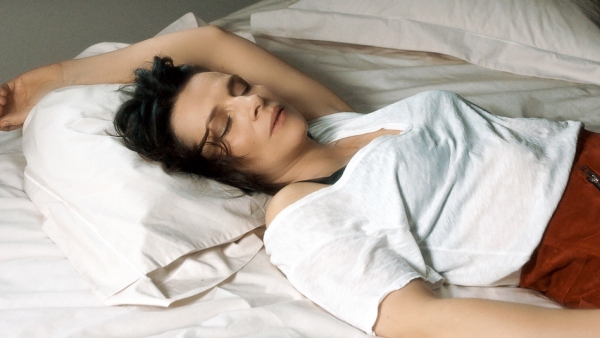
RS: She is luminous.
AG: Oui, oui. And the light comes from her. It’s like the skin is shining. Though she’s tormented, she is like that. She’s abandoned but still the light is on. In the film, she’s sad because she’s looking for the great love of her life. But she could be brave. She has the strength, the courage, even though she’s fragile, to show what she is. She doesn’t hide herself. That’s her personality. And who could destroy this beauty? I don’t know. And the texture: you would like to touch maybe, but then you can’t. And as long as you can’t, you desire. I believe in that kind of image.
RS: Shall we try another from the same film? Here is Gérard Depardieu in the final shot, that incredible long take.
AG: This image is a little bit horrible—I mean the transfer. It’s not your fault. It’s because this sequence was very long, like 15 minutes, and we shot in one piece. We did several takes. And at the very beginning of the second, he is in a shadow, and, while the scene is going on, the light goes up and the sun arrives somehow. They are lit by the sun. The inside sun! [chuckles, referring to the French title, Un beau soleil intérieur] He’s talking about somebody else while in fact he’s telling her that she’s beautiful and he’s very attracted [to her]. Gérard Depardieu had something in his ear to say the dialogue and had a very slow rhythm, and it was fantastic because it was really like he was inventing the dialogue while he was saying it. I really liked that very much. And then at the beginning for [Binoche’s shot], she was darker and then slowly the light would go up and [get] quite warm, to open the door of a possibility of an encounter and maybe a relation and maybe a love.
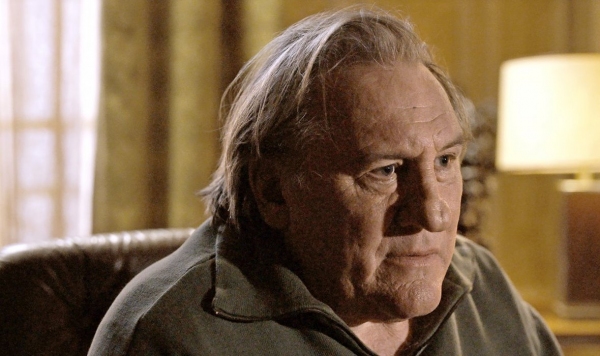
RS: It’s hard for me to remember in Denis’s work such a long take where the camera is not moving in some way.
AG; You’re right, but the entire film was a totally new approach or style or way of narration, with so many dialogues from the first scene on. That’s also why I wanted these lenses and the camera to have a texture in the image, because I was thinking, how do we feel dialogue? It’s very difficult to find the decoupage or the image of a film where people are talking a lot. And I think Claire’s conception of the film was really smart concerning that. The locations were always very small, which is difficult for the image and especially for the light, because to light someone from a very close distance is much more difficult than using big lenses from far away, like the sun. But we were so close that, for me, it meant that it was to hear the words when they were talking. This end sequence with Gérard Depardieu was really a challenge, but it worked. And Claire also had to have the credits going [over the image] as if it’s not the end of the film. Maybe this is where it starts! [laughs]
RS: Let’s go back a little and look at 35 Shots of Rum. Perhaps a less typical shot: the first with Alex Descas and Mati Diop, riding a motorcycle.
AG: Probably this sounds far off [chuckles], but it’s the simplicity [here]: maybe it’s Japanese, Ozu. I see a couple—I have no doubt. It’s not a married couple, it’s a father and a girl, and there is something affectionate. And without looking at each other, they are going through this close, intimate moment. I remember I think the light was moving a little bit as if they were going through the light changes when you’re going along a street. I do love and believe in this kind of a simple image, because you don’t need to see anything else. That’s what I like with Claire: to be so radical to choose images that will be just enough. I remember that at one moment there is a pan down and she is wearing wool gloves, and then going back to their faces, because they are also beautiful—that’s also Claire’s choice, of course.
And each one of them is secret. You are the witness of a very intimate moment with strong love, but they are separate and very mysterious. And of course, mystère [mystery] is an essential element in cinema because you want to know about something mysterious, so you want to look. It’s an essential chemical agent to make a link between the fiction and the audience. And that’s why, if the mystère is there, you don’t need that much more.
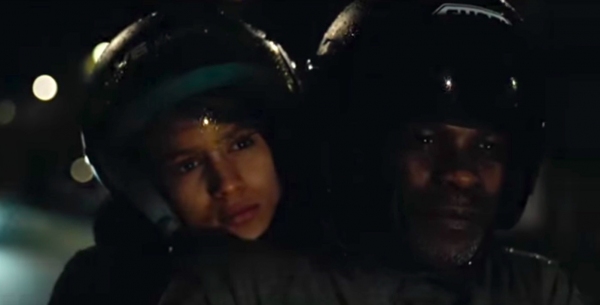
RS: I’m curious, when did you first meet Claire Denis? Can you remember what it was you first connected or bonded over?
AG: When I was in cinema school, I had a boyfriend who became my companion and father of my daughter; we spent 27 years together. He was an assistant director, and he had been working with Claire for approximately two and a half years. At the school I wrote a short film that I wanted to direct, dedicated to my father. And right after school, I got a grant to do it. I didn’t know Claire very well, I met her briefly maybe two or three times before, but to prepare this short film I wanted to direct, I needed advice. And I just got in contact with Claire, asking her advice. When this film was finished, I organized a screening and of course I invited her. And after the screening, she said, “If I ever do a film one day, would you work with me?” At that time, I was a camera assistant. And it was the beginning, eh?
A few weeks or months later, I was offered work on Paris, Texas as a camera assistant, and I discovered that Claire was going to be the first assistant director on the film. So we went through Paris, Texas together and then a little bit later I was referred to work on Wings of Desire and this time I was operating the camera and Claire was 1AD. She had already written her first film, Chocolat. And she said, “Okay, I have a script, I have a production, would you work with me on this film?” I said yes, and it happened a few months later. She said I could also do the image also [i.e., be DP], but I was very inexperienced and so the producer thought it was foolish. But I operated the camera. That’s how we met. [chuckles] Voilà.
RS: It’s crazy that someone would think you couldn’t be the cinematographer, because soon after, weren’t you shooting Jacquot de Nantes for Agnès Varda?
AG: Oui. It was also a really funny story, because once again, my short film is involved. Agnès Varda started to shoot a film with a friend of mine, Patrick Blossier, in the spring. Maybe for three weeks or something like that. At that time, the film was supposed to be a short film or medium film, she didn’t know, and then she realized it was turning out to be a feature film. But Patrick Blossier could not stay on the film. So Agnès Varda said, “Okay, but you have to find someone to replace you.” Patrick showed my short film to Agnès Varda, and she liked it and said, “Okay, I want to meet her.” I went to see her and she said, “Okay, you’re going to work on the film!” That’s how I worked for seven weeks, I guess, in Nantes. There was a pause because Jacques Demy was not feeling well at all, and the film was stopped and then started again during the fall. I was not able to do that part because I had said [I would work with] Henri Alekan, who was already very old, and I thought maybe that would be the last time I would be working with him. So, another DP did the last two weeks on Jacquot de Nantes.
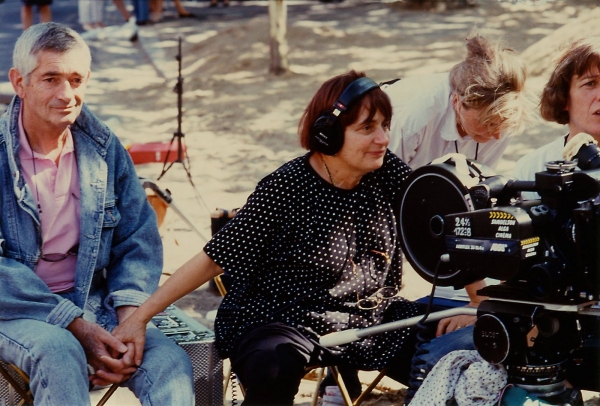
RS: What was it like working with Agnès Varda?
AG: Agnès was very impressive. She was like a chief general in an army, driving all the crew. [laughs] I was very scared because she’s a photographer, you know, and I thought, well, she’s going to—but no, it was okay! She was extremely interesting, and the way she was jumping into Jacques Demy’s childhood memories was fantastic. She was very pragmatic. She had so much documentation about World War II, about life, about everything. She would fill the place with little objects, props, that would be reality, and then we would find out how to make this alive. It was very interesting and at the same time very simple. She would take things from daily life, look for a little symbolic detail for the story, to tell how Jacques Demy slowly followed this line to being a director.
RS: How was it different setting up shots for this film compared to others?
AG: I had no way to compare because that was the very beginning. But she would... I don’t know if it’s the exact word, but [it was] this journalistic thing! She would make a mise en place that would induce the way to film. You would understand right away how to look at the shot. It would be very simple. It would be comme une pelote de laine qui se déroule [like a ball of yarn that unravels]. Like a negative roll in a spool of film. Of course, she had an eye—sometimes she would announce that it would be a 40mm lens or maybe a 50. It would be easily understandable.
RS: So, what was the first film with Claire on which you were DP?
AG: I don’t remember if it’s the documentary about Jacques Rivette or I Can’t Sleep. When I worked with Claire on Chocolat it was operating the camera, and the same thing for No Fear No Die. Cinéma de Notre Temps [the Rivette documentary, part of the French TV series] was supposed to be a one-hour film, but Claire proposed this conversation with Serge Daney on the roof of the newspaper Libération over an entire night. So it became a two-hour film. One during the day, one during the night. It was a fantastic moment.
RS: A bit of an adventure like Rivette’s movies.
AG: Oui. Exactly. It was beautiful to see how Serge Daney could ask questions, and how Jacques Rivette would talk, because he was a little bit shy. I thought this night was a fantastic idea, because it was like a confidence [a secret], it was not an interview. It was definitely about not only the ideas behind making films, but the thought that would shape the ideas. And I think somehow there is something about that in Claire’s work.
RS: Can we go back to Henri Alekan [DP of Wings of Desire and Cocteau’s Beauty and the Beast] for a moment? A cinematographer once told me that he wrote a book that is like a Bible for shooting movies.
AG: Oui. Maybe he’s referring to Des lumières et des ombres. Yes, that’s a gigantic book that Henri wrote. As a matter of fact, one day Henri invited me to go and see him, and he said, come on, I want to show you something in my office. And he showed me a big document with papers in every direction, and I said, “What is it?” And he said, “It’s a book!” [laughs] It was all handwritten! And I said, “Would you like me to type it? So it will be [makes sound of clapping a book shut] in one piece!” And he said yes. So I rented an electric typewriter and typed this book.
RS: So you know it well!
AG: It’s fantastic because when I met Henri, he was already part of cinema’s history. But he so enjoyed being with young people and transmitting his knowledge. His life! All the things he went through and all these thoughts, he put together in this book. It’s so rich. And in this book, the message is that light is an element of directing. You participate in the narration of the film with the light, with the ambience, with the climat of the image. So, the image is not only a technical performance, it’s part of the storytelling, it participates in the narration. And that’s the deepest definition, I think, for cinematography. Because a cinematographer is a companion or is a translator, maybe, but he’s working for the film and the director. We have to understand, to try to guess, the invented world the director is looking for. And Henri, because I worked with him a little bit, I could see that he was a mix of a very high level of technique and a high level of artistry. He would consider each film as unique, and he would invent so many things! He dedicated his whole life to that. I remember when I went to see him for his 90th birthday, he said, “You know, I’m really embarrassed because my days are too short, I cannot do everything I would like to do!” [laughs]
RS: He wanted 90 more years!
AG: Yeah! But you know, he and Sacha Vierny were part of history already. It was different when I worked on Paris, Texas, seeing Robby Müller and Wim Wenders working together. I had the feeling that they were going to be part of cinema history, but it was the present, closer to my own time. And it was a privilege to be a witness to that. That’s also what’s so fantastic about cinema: everything is moving all the time, going forward and forward and forward. Maybe as Henri was saying, it keeps you young.
RS: Talking about cinema moving forward, I have to think about Beau travail, which felt like a milestone at the end of the 1990s. Which image would you like to talk about?
AG: Maybe the guy on the salt sea.
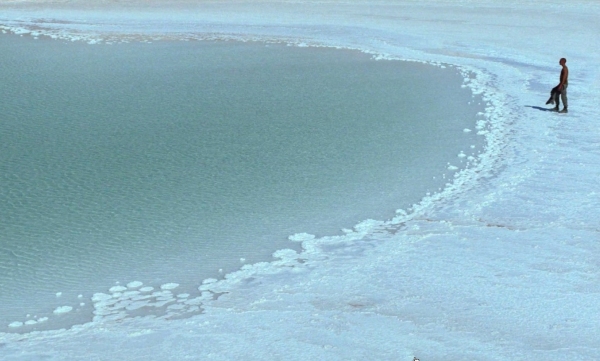
RS: A beautiful framing!
AG: Yeah... Beau travail remains a unique experience because it was not very simple or minimalist. I would say “primitive.” Because Claire had this idea to shoot in Djibouti, which is an incredible part of the world: when you arrive there, you don’t know if it’s the beginning or the end of the world. And there is—what—desert, some sea, volcanoes, sky, stone, and that’s it. And of course, the Djiboutians, but sometimes very far away. Figures in a landscape. It was the perfect situation to find—I don’t know if it means something in English—générique images.
For instance, in the beginning, they are in a little boat and there is a succession of a quite medium shot, close-up, of all the legionnaires, and for me, just with this image, once more in full light, it’s an image of a military person, a legionnaire. The situation was also unique because we never saw one image during the shoot [no rushes], and so we were blind, you know. And the guys [actors] did very hard physical preparations in Paris, everyone except Denis Levant, who doesn’t need it because he’s already strong enough. And it’s so radical. Every day we experienced faith in cinema and in cinematography. And that gives you wings.
RS: Speaking of the actors, how much do you work with them as you set up shots? I don’t know if Denis Lavant is a special case.
AG: No, there is no special case. I look at them as long as I can, as much as I can. Claire’s [way of] working allows that. I look at them as if—maybe—it’s the first time. Just to try to get what’s in their minds. [chuckles] But each time I work with Claire I am amazed by the choice of her casting. Each time I would be totally hypnotized by the faces. I think faces are such rich landscapes. You could always discover something looking at them. And I think that she organized the shooting so that we could keep looking at faces and bodies!
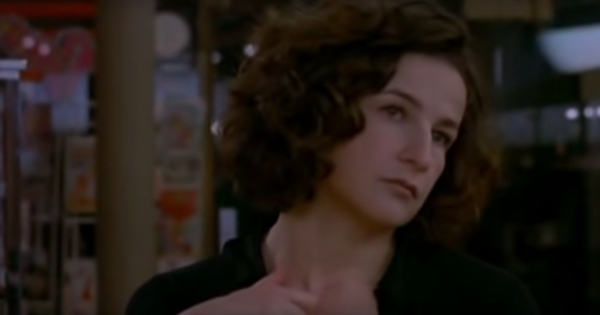
RS: Let’s look at another image. I really like Friday Night and its feeling of connecting from a distance.
AG: Yes. It was quite a challenge because it was shot entirely at night during wintertime. And finally, we decided to work in a normal car. No special car with a piece [removed]. This is Claire’s choice, because that way we could be inventive in finding the place of the camera. It’s more organic somehow. We used an Aaton 35mm camera—this fantastic camera you can do everything with. Claire was also very inventive because the story is set during the night of a strike. The entire city is on strike, so there is a gigantic traffic jam. Of course, we couldn’t have a lot of cars to shoot the film. So Claire decided that we should be able to have maybe a lot of cars for two or three days and then try to find a way to shoot in close-up only part of the cars to make the illusion we were still in a gigantic traffic jam. And it worked! The only thing that was [chuckles] a bit complicated: [the star] Valerie Lemercier doesn’t drive. [We both laugh]
So, at one moment we had the camera on a crane above the street, to see the line of cars going slowly, and at one point she had to change the lane. And she could not, because she doesn’t know how to drive. She could not do it! So there are two guys behind the car pushing the car. [laughs] I think we still see one a little bit, a shadow. We were laughing, but it worked. But I really enjoyed it because you know the concept was that if you film only a part of things, you will have the feeling that you see the whole thing. It’s metonymy, we call it in French. And definitely this is a main concept of Claire’s [way of] working. That’s why she doesn’t cover herself [shoot coverage]. We count on finding an image that is sufficient in itself, and we don’t need to have another shot.
We did a shot in the hotel, and the ambience was what Claire was looking for, but it was very, very, very small. The bedroom was so small that it was decided we would do it in a studio. The same thing happened for the pizzeria restaurant and the toilet of the pizzeria: we did it in a studio. And I really enjoyed it, it was fine to mix real location and the studio.
Another thing was that Valerie Lemercier used to do one-woman shows. So she’s used to being seen from far away. She’s very careful, very precise about the design of her silhouette and so on. I discovered that, because before the film, we decided to shoot some tests with her, and we went into a hotel. We started to film her on the bed, and I saw that when I was close to her, filming her, it was very violent for her. She was afraid, she could not stand to be seen with a camera so close, and that’s how I realized that she’s used to being in a theater. I told Claire, “I see that after a little while she’s suffering.” It got better, but still I could feel sometimes that she was not so comfortable to be filmed like that.
But for all these things, you have to find a way as a DP: you have to make them comfortable and confident. It happens less now with digital because everyone is in front of the monitor, but before, sometimes after the cut, the actors would look at me behind the camera to see my face, to see if it was okay. They do it also because with the monitor, sometimes the director is not so close. I remember this was going on in this film. It was really very exciting to be in this car and to film things with extreme close-up. How they were watching each other without showing it. And sometimes we were very close with the camera, because the car was a normal car, not a large American car! [chuckles] Sometimes that means we spent time in a W shape, all day, for a few weeks.
RS: You have to do yoga after that.
AG: Yes! Exactly. Gymnastics. Because you need the guy for the sound, the first camera assistant... But I like this film: very poetic and very romantic.
RS: We’ve talked about filming beauty and love. But what is it like to film something violent? Like Trouble Every Day or Bastards. What goes into filming their menacing scenes? They’re powerful yet not always explicit. It’s the metonymy again, perhaps.
Yes, exactly. I’m not scared [to shoot these scenes]. For Trouble Every Day, maybe this is a bit strange, but when we shot this very violent scene between Béatrice Dalle and Nicolas Duvauchelle, I did not think about horror film. I decided that it should be seen as a love scene that becomes cannibal [cannibalistic]. I didn’t want to film something that would be only scary or cruel. I wanted to find somehow a link between the sexual situation and the fact that in this sexual situation, which is supposed to be a fusion, each partner is on his own. And I was thinking about Lacan, who said that the sexual act sometimes is “Yum, yum!” [laughs] Do you know this? Yum, yum! When you eat something. When you are talking to a kid: you say, “Okay, it’s time to eat, mmm, yum yum!” He said, “It’s yum yum for me!” And I thought about that!
Plus, there was the fact that we didn’t know how Béatrice Dalle was going to act. We didn’t know! And I was even more amazed by the way she was acting as a human being, but with this little cry or shout, like a little animal. The sound of her voice was not cruel, it was like a need—like a cry that a kid would make when he’s asking his mother for something. And I think it was like a disturbed sexual love rather than horror. I know that some people during the screenings could not stand that.
And I think that this belongs to Claire’s body of work: the exploration of what is taboo. Any form of taboo. She’s always arriving at the border of that. The taboo: to go past or not, being a human being and being an animal. In terms of my job finding an image, I never looked for something totally on the other side of the taboo. I just have elements of images that, put together, let you think that we are on the border of taboo.
Top photo: courtesy Isabelle Buron - IB Presse
